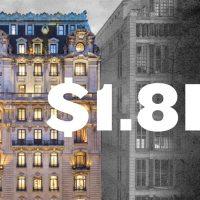It’s not the $2.2 trillion that House Speaker Nancy Pelosi wanted, but the $900 billion federal aid package approved Monday has serious funding for real estate: $325 billion for small businesses and $25 billion for rental assistance.
The rest of the stimulus — including $166 billion in checks, $120 billion for unemployment and $45 billion for transportation — will help the industry indirectly by sustaining shopping and transit systems. It will provide a figurative shot in the arm while millions of Americans get a literal one.
Its omission of funding for city and state governments, however, means real estate will have to fight next year, in New York and probably elsewhere, to stave off tax increases.
Covid cost New York governments a lot of revenue. Not as much as initially feared — because Wall Street’s big year will generate big tax payments — but more than lawmakers are inclined to make up by cutting spending.
For the state, the biggest mouths to feed are not agency employees (contrary to what the average Joe thinks) but education and health care. No one should expect Albany to slash these funding streams to balance next year’s budget.
Both industries have powerful lobbies — think teachers’ and health care unions, hospitals and nursing homes — and lots of allies in the legislature. They are all well practiced in stirring up public outcry over Johnny’s teacher potentially getting laid off or no nurse answering the bell when Grandma presses the call button.
Read more



The real estate lobby that its critics think is so powerful can only dream of having the kind of pull in Albany that education and health care do. Simple math will force the Cuomo administration to find savings from schools and Medicaid, because that is where the money is, but when it comes to tax revenue, real estate’s favorite customers are a likely target.
Fights for a pied-à-terre tax and another millionaires’ tax will start to heat up in January and carry to the end of March, when the state budget is decided. Taxing second homes is easy pickings politically, because they are owned by the well off, many of whom live outside New York. Lawmakers are not too worried about the political fallout from enacting a tax that shaves, say, 10 percent off the sale price of non-primary residences worth $5 million or more. (The technicalities of enforcing one are daunting, but that’s another matter.)
Legislators might also add a top-tier income tax to the current statewide millionaires’ tax of 8.82 percent, which combined with New York City’s income tax gives the Big Apple the second highest maximum income tax rate in the nation (behind California). Gov. Andrew Cuomo has held off tax increases since taking office in 2011, but this month said they are likely without federal aid. And he got no aid in Monday’s bill.
There is a debate about whether the rich will flee New York if taxes are raised. That is the wrong question, though. If the tax rate were raised to 100 percent, of course they would leave. The issue is how high a rate they will tolerate.
No one knows the answer, despite anecdotes about people moving to Florida, which has no state income tax. Indeed, the number of billionaires in New York City has increased since the first millionaires’ tax was passed in 2009. It’s apparently in the triple figures now, up from the 70s back then. It seems some folks are too busy making enormous sums of money to bother changing their tax residency, or just live wherever they want because they can
“The key is making sure that you are competitive relative to other jurisdictions,” said Andrew Rein, president of the Citizens Budget Commission.
What about New York City? Its budget problems have turned out to be not as bad as Mayor Bill de Blasio claimed when he was pleading for a federal bailout. Thanks again to Wall Street and low interest rates (which allowed for debt refinancing), and to previous stimulus bills fueling the economy, this year’s budget is balanced at $92 billion.
The next one, beginning July 1, officially has a $3.8 billion deficit — and unofficially $4.8 billion if you add the $1 billion in savings from unions that they and the mayor promised five months ago but have not delivered.
Fortunately, the city has $2.8 billion in reserves. Exhausting that would bring the deficit down to $2 billion.
The unions should be able to pitch in their billion (consider that more than 90 percent of unionized city employees pay nothing toward their health benefits, and lots of retired city employees get city-funded health care until they turn 65 and qualify for Medicare).
The final billion could come from things like attrition — not replacing workers who leave city service. Would that hurt the quality of life that the real estate industry depends on? Not by much. The industry did pretty well when the city’s headcount was 297,000 halfway through de Blasio’s first year in office. Six years later, it was 324,000. Universal pre-K accounted for only 6,000 of the gain. The main impediment to cutting spending is the mayor’s ideology, not the idea that the city would fall apart.
The final leg in the three-part stool that underpins real estate is the transit system. Congress is sending only $4 billion of the $12 billion that the Metropolitan Transportation Authority said it needed to avoid massive service cuts. That buys the MTA time to find recurring savings that close large budget gaps in 2022 and 2023.
“The subway is the lifeblood of our economy, without question,” said Rein.
Citi Bike will not bring office workers and tourists back to Manhattan. For New York metro area real estate to recover as the world is vaccinated, the trains have to keep coming. But the industry does not want to kick in more tax money for transit, as it did a year ago to fund the system’s capital plan.
It is conceivable, but not especially likely, that Congress will make cities, states and transit systems whole with a future aid package. They are essentially on their own, which will keep real estate’s lobbyists busy in 2021.
